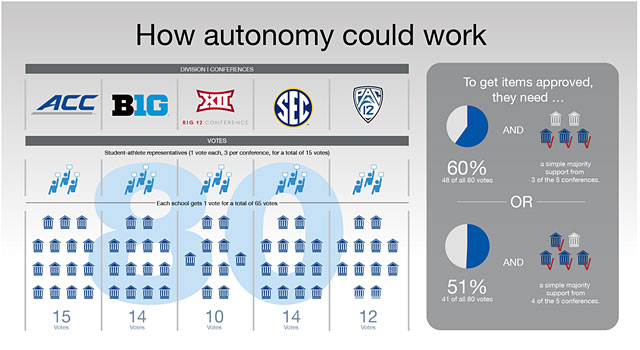
More college football: Dennis Dodd | Jeremy Fowler | Latest news
College sports' Power 5 conferences got what they wanted from a revised NCAA governance proposal released Friday. There will be a lower voting threshold for the SEC, ACC, Big Ten, Big 12 and Pac-12 to make their own rules to benefit athletes.
When the draft proposal was released in April, it required approval of two-thirds of the 65 Power 5 schools (plus 15 voting athletes) and four of the five conferences to enact legislation. But several conference commissioners and university presidents in the Power 5 said the voting threshold could cripple the concept of autonomy.
Under the new proposal released Friday, there are two ways for the Power 5 to pass their own legislation regarding certain issues:
* Get 60 percent of all votes (48 votes) and a simple majority support from schools in three of the five Power 5 conferences; or
* Get a simple majority of all votes (at least 41) and simple majority support from the schools in four of the five Power 5 conferences
The idea is to pass legislation that would provide more benefits to athletes. If the new governance model is passed, the first plan by the Power 5 conferences is to adopt a cost-of-attendance stipend. The NCAA and Division I conferences face lawsuits over capping scholarships values.
The Division I Board of Directors will vote Aug. 7 to decide whether to pass the revised governance proposal. If it passes, there will be a 60-day override period for the membership. At least 75 schools would have to request an override to require the board to reconsider the rule change, and 125 schools are needed to suspend the rule change until the board meets to reconsider. (Colleague Dennis Dodd breaks down the ramifications of what could happen if the Power 5 doesn't get what they want.)
The NCAA steering committee removed transfers from the autonomy list for the Power 5 conferences -- with a caveat. “The five conferences requested autonomy over transfers if substantial change isn’t accomplished within the new structure’s first two years,” the NCAA press release stated.
For instance, SEC executive associate commissioner Greg Sankey said this week, is the one-year graduate student transfer rule meaningfully focusing on education, or is it simply a way to transfer and play right away? Sankey said schools must also discuss how to avoid having too much control on transfers while letting students make decisions they need to make.
The NCAA also released 101 pages of comments from various Division I conferences and administrators since the initial proposal came out in April. Many of the comments supported the overall concept of autonomy for the Power 5 conferences.
But some of the responses reflected the tension in Division I, particularly over what legislation the Power 5 is allowed to create and weighted voting involving shared issues between the Power 5 and smaller conferences. Under the revised proposal from Friday, the weighted voting totals on shared issues would be:
* 37.5 percent for the Power 5 conferences
* 18.8 percent for the remaining five FBS conferences
* 37.5 percent for the FCS and non-Division I football conferences
* 3.1 percent for college athletes
* 3.1 percent for designated faculty athletics representatives
Comments from smaller Division I members
Even if the NCAA structure passes by the board, as expected, and does not get overriden by NCAA members, some of the comments reflect the challenges for Division I with this model moving forward. Here are some of the comments offered to the NCAA revealing that tension:
* Montana State athletic director Peter Fields said the new structure does not provide more agility to deal with evolving issues in college sports. Fields wrote that the “perpetuation of idea that the Big-conference group knows what it wants may not be an accurate assumption.”
Added Fields: “It is evident that Big 5 athletic administrators from President’s to (senior women administrators), do not trust representational governance. They have shown time and again that to them shared governance means to share within the group of 5 as they know best what is good for the Association. This thought process has not been beneficial to the overall wellbeing of the Athletic enterprise on campus and across the nation. I assert that we presently have what the power group created, and now they want something different for a myriad of reasons. Question to end: on other than the top 20 or maybe 30 revenue-producing athletic departments, who does this change really benefit? Does this really benefit the student-athlete?”
* Indiana State athletic director Ron Prettyman said he supports autonomy or weighted voting for the Power 5 conferences, but not both.
“Why is it important that the schools from the 5 highly funded conferences not only have autonomy but also expect the authority of weighted voting?” Prettyman wrote. “It makes no sense that the 65 schools from the 5 highly funded conferences control the voting processes and opportunities of the 300 or so schools that are not a part of the 5 highly funded conferences. … The gap is getting wider and the opportunities are getting greater for the 5 highly funded conferences while the opportunities are being diminished for everyone else.”
* The Atlantic Sun wrote that it was “puzzled” why it’s necessary to provide weighted voting on issues of equal concern to every NCAA member. “Are academic standards, for example, any more important to an SEC school than an Atlantic Sun school?” the Atlantic Sun wrote. “We think not. … We’d strongly prefer a ‘one member, one vote’ approach, which we believe (is) in the best overall interest of Division I, both the institutions and the student-athletes.”
The Atlantic Sun said it accepts autonomy for the Power 5 but expressed concern of how far those conferences will go. The Atlantic Sun even suggested that perhaps autonomy should be granted to the other 27 conferences to separately consider legislation not driven by the Power 5 conferences.
* Northeastern athletic director Peter Roby wrote that he was concerned about the “unintended consequences” of giving the Power 5 conferences autonomy and letting the rest of Division I adopt their legislation as well. “I fear it will drive a wedge between schools in the same conferences and result in more conference realignment and lost trust among conference members, not to mention the continuation of the ‘Arms Race’ we have witnessed over the last 20 years,” Roby wrote.
Roby raised the possibility of a “sunset provision” included in autonomy legislation that allows the NCAA to revisit the structure in five, seven or 10 years. Roby also said there should be equal voting on issues impacting the larger and smaller conferences.
“Many of the items highlighted for autonomy already exist,” Roby wrote. “This suggests that the call for autonomy is more about public perception and less about true governance reform. So much of what inspired these changes involves football…why not make any governance changes limited to just FBS football?”
Roby wrote that if the Power 5 conferences are “recruiting students with a realistic chance to graduate then the amount of academic support the Autonomous 5 conferences provide their athletes should already suffice.” Roby noted that athletic directors “better be prepared for the work load and responsibility the new governance structure requires of us.”
* College of Charleston athletic director Joe Hull said that although the problems facing the Power 5 conferences are real and that he worked in a Power-5 conference for 23 years, he has concerns with autonomy.
“I want to help the Big Five solve their problems," Hull wrote. "But legislative autonomy is, at best, a short-term solution to a long-term problem. It will not work long term for the Big Five primarily because it does not directly address the sources of the problem.”
Hull said one problem is the perception that the major conferences are focused more on revenue than education. “Ironically, the whole concept of legislative autonomy for the Big Five seems to verify that the focus is on revenue,” he wrote. “Essentially the concept is that the high-resourced conferences are generating billions per year in revenue, and they need to be able to spend it without input from those who do not have similar revenue. The best solution is for the NCAA and the Big Five to take some small percentage of these new revenues and share across all of Division I, to the benefit of student-athletes at universities far and wide. The Big Five would be smart to embrace those lower resourced universities outside the Big Five whose focus is clearly on education.”
Hull said another problem with autonomy is it tries to fix all sports rather than “focusing on where the real problem is -- FBS football and men’s basketball.” Autonomy will damage and “perhaps destroy” what’s left of a level playing field in Division I sports, Hull wrote. Hull recommended three separate management councils for football, Division I men’s and women’s basketball, and all other sports, and include a commissioner for each category.
In addition, Hull recommended that the NCAA consider asking Congress for an antitrust exemption or relief from antitrust rules so schools can control over costs. The escalation of costs associated with salaries, facilities and other items “is on an unsustainable path,” Hull wrote.
* The American Athletic Conference said it wants a process or criteria for adding or removing conferences from the autonomy group. The American used to be the Big East, which had a BCS bid, but is not part of the five Power 5 conferences who have the ability to create their own legislation. Under the proposal, the American and other conferences could adopt some of the "permissive" legislation passed by the Power 5.
The American wrote that “it should be made explicit that mobility in either direction is possible.” The conference recommended that criteria for being autonomous could include a conference’s increased resources to help athletes, its competitiveness at the highest levels, its media exposure and sources of revenue, and the similar scrutiny it may receive nationally on issues such as NCAA enforcement, transfer policies and national governance. The American suggested decisions to enter and exist autonomy could be made by the Division I board or Division I membership.
Also, the American suggested establishing a group that examines proposed legislation that’s shared in Division I prior to a vote. The American wants the people in this group to have experience interpreting and applying rules on a daily basis, such as a financial aid officer who understands federal guidelines to review financial aid legislation.
* The Southern Conference wrote that the most common concern from its members is compromising the model in which students use “an opportunity to receive a sound education while playing a sport they love.”
Added the Southern Conference: “Discussions regarding permissive legislation aimed at reducing recruiting and competitive disadvantages will become divisive topics between and within conferences. We believe institutions will be forced to make decisions about which programs they can support and which they cannot. This will drive wedges between student-athletes on our campuses, reduce opportunities and further erode the current structure.”
* The Big South Conference said that although it supports autonomy given the pressures felt by the Power 5 conferences, the process “became more difficult to accept” when the autonomy list went “well beyond” resource issues. “There is very little clarity on the overall impact of these new autonomy areas, and there continues to be significant discomfort in departing from our usual practice of having intent and rationale clearly stated prior to approving legislation,” the Big South wrote.
* The Mountain West Conference wrote that it supports permissive legislation, but sought clarification on what issues the Power 5 conferences could implement. “Areas requiring a higher threshold for approval should initially include changes to transfer legislation, membership requirements and athletic grants-in-aid,” the Mountain West wrote.
* The Big East, while supporting most of the changes, expressed concern that the initial proposal didn’t give the non-FBS conferences enough of a voice on the Division I board. That proposed structure has changed.
The model released Friday shows a 24-member Division I board with five presidents from the Power 5 conferences, five from the remaining FBS conferences, five from the Football Championship Subdivision, and five from Division I schools without football. Also on the board would be chair of the student-athlete advisory committee, chair of the council (which will handle the daily work of Division I), a faculty athletics representative, and a campus senior woman athletics representative.
In its letter to the NCAA, the Big East noted that although the revenue stream is increasing from the College Football Playoff, those funds don’t flow to the NCAA or directly support the association. Yet, the Big East noted, the NCAA is responsible for issues such as player eligibility, rules compliance and enforcement, and management of playing rules, legal services and research related to health and safety.
“We believe this fragmentation has governance and other ramifications and encourage the Steering Committee and the Board to examine this anomaly as part of their continuing review of the NCAA’s functional responsibilities and funding model,” the Big East wrote. “At the very least, the exclusion of football-related revenue from the NCAA’s budget only underscores the primacy of basketball interests to the overall operation.”
The Big East wrote that “due to competitive concerns” it believes team scholarship limits should remain permanently in the shared governance category. The Big East requested the subject be excluded from potential future movement to autonomy. Also, the Big East supported the Power 5 conferences modifying the transfer policies if “the best efforts of all conferences fail to produce a consensus after a reasonable time.”
* The Ivy League wrote that financial aid autonomy should not allow the ability to “stockpile” players by increasing scholarship numbers and limits and should specify that athletic scholarships may not exceed cost of attendance.
The Ivy League also believes time demand autonomy can’t expand the playing and practice season or other time demands; recruiting autonomy can’t expand current recruiting timeframes; and personnel autonomy should be limited to non-coaching positions with coaching limits remaining part of shared governance. Also, the Ivy League said pre-enrollment benefits to athletes is a “critical area that could directly impact institutions’ ability” to recruit players and should be limited to shared governance or to players who have signed National Letters of Intent.
* In a position paper from the American Athletic Conference, Conference USA, MAC, Mountain West and Sun Belt, the conferences said they feel “strongly” that FBS requirements, transfer legislation and scholarship limits for all sports should be shared governance. “It is acknowledged that future academic changes, such as freshmen ineligibility, might necessitate a very limited increase in scholarship limits,” the other five FBS conferences wrote.
* In arguing for a seat on the Division I board, the MAC cited its inclusion in multiple lawsuits challenging the legality of the collegiate model. “Two seats from the Group of Five would create a de facto ‘Division IV’ which was never the intention of this process,” the MAC wrote.




















